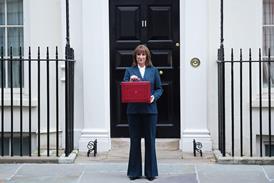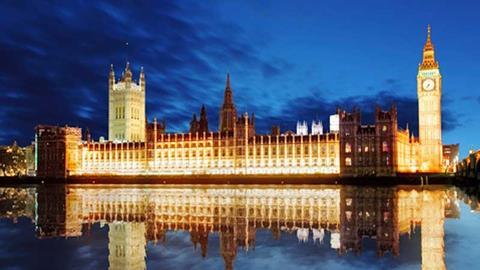A year on, have the legal profession’s doom-laden predictions about the impact of deep civil legal aid cuts been realised?
Last week, April Fool’s Day marked the first anniversary of the introduction of the Legal Aid, Sentencing and Punishment of Offenders Act 2012.
The Act, fiercely opposed by lawyers’ groups including the Law Society and Bar Council, saw the most drastic shake-up of civil legal aid since its introduction in 1949, removing whole swathes of law from scope in one fell swoop. A turbulent passage through parliament saw the bill defeated an unprecedented 14 times by peers, before eventually passing by a narrow margin.
As criminal lawyers battle to stop the Whitehall scythe inflicting further damaging fee cuts, their civil colleagues can only lick their wounds.
LASPO turned off public funding for: most private family cases (except those involving evidenced domestic violence, child abuse or abduction); welfare benefits; clinical negligence; employment; housing disputes (other than serious disrepair, homelessness or anti-social behaviour); debt; immigration; and education (except special needs cases), removing advice from 650,000 people.
The cuts were necessitated by the comprehensive spending review, which demanded that the Ministry of Justice, then led by Kenneth Clarke, shave 23% off its budget between April 2011 and 2015. Clarke’s plan to reduce prison numbers by allowing greater sentence reductions for those who pleaded guilty was deemed unacceptable to Conservative supporters and the press, and was vetoed by Downing Street.
So it was that the civil legal aid budget bore the brunt of the ministry’s number-crunching – accounting for £279m of the £350m that needed to be saved. Labour’s shadow justice secretary Sadiq Khan branded the bill ‘an act of vandalism’, calling its passing a ‘sad and tatty chapter in the story of post-war access to justice’, though to date the Labour party has made no commitment to reverse the cuts.
Jonathan Djanogly, then justice minister, countered that reform would ensure ‘we will continue to have one of the most generous legal aid systems in the world’. He assured critics that legal help would remain widely available, together with a range of options to help avoid court action.
So was the legal profession correct with its dire warnings about the denial of access to justice for thousands of vulnerable people; firm closures creating ‘advice deserts’ and unmet need; a tilting of the playing field between the haves and the have-nots; and increasing numbers of litigants in person, with the knock-on impact of delay and cost?
The MoJ takes the view that it is too early to assess the impact of the act, though it is ‘closely monitoring’ the situation and will do a thorough assessment ‘in due course’. However, a growing body of evidence highlights worrying trends.
Where data exist, concerns focus on the under-use of the exceptional funding scheme; the drop in family mediations; an increase in litigants in person; and the difficulties for domestic abuse victims of passing the evidential eligibility test.
Research published last week by national firm Simpson Millar demonstrates the impact on family cases. The firm is turning away more than 50% of enquiries from those who would previously have been eligible for legal aid, with a drop in legal aid cases from 42 in February 2013 to 19 in February this year. The report, published jointly with probation union NAPO, coincided with a 48-hour walk-out in protest over plans to privatise probation.
Cafcass figures, which relate to family law disputes involving children, show that before the cuts 60% of cases began with one party being represented and 22% with both parties represented. Only 18% of cases began with neither party represented.
By December 2013, only 4% of cases started with both parties represented and 42% with neither side represented. The report suggests the cuts resulted in more cases being contested, with a 27% rise in applications relating to access and custody, and lawyer-free cases taking longer.
Restrictive criteria
The Cafcass figures also suggest many victims of domestic abuse are unable to meet the restrictive criteria set by the Legal Aid Agency in order to receive legal aid, meaning partners and parents remain in abusive relationships. Women’s rights groups published a report showing 47% of the 117 domestic abuse victims they surveyed took no action in relation to their family problem as a result of not being able to apply for legal aid, while 25% represented themselves.
Highlighting the distances they had to travel to see a legal aid solicitor, the survey revealed that 43% did not have the prescribed forms of evidence to access legal aid and 23% had to wait longer than two weeks to obtain it.
In response, the ministry maintains that the latest figures show that family court performance ‘is being maintained’ and the average time taken to complete cases ‘remains steady’. The MoJ insists it has ‘listened closely’ to concerns raised and is widening the types of evidence that can be accepted to prove abuse.
To compensate for the removal of legal aid in private family cases, the ministry punted mediation as the panacea – keeping cases out of the hands of lawyers and away from courts.
The court has become a ‘default option’ for many, according to the MoJ, and it wants to make sure people use a less stressful option where appropriate.
Notwithstanding that ambition, figures show the policy has proved a failure. Statistics compiled in response to a freedom of information request from Marc Lopatin, founder of Lawyer Supported Mediation, show family mediation referrals fell nationally by an average of 26% for the three months from April to June 2013 compared with the same period in 2012.
Over the same period, the number of couples attending MIAMs (mediation information and assessment meetings) plummeted by 47%.
Although legal aid remains in place for family mediation – lawyers are paid £150 for supporting clients through the process – Lopatin suggests that because separating couples are told legal aid for family law cases is no longer available, they pursue cases themselves without seeking legal advice.
The inadequate operation of the exceptional funding mechanism is another key concern. Much-vaunted by ministers as the solution to all difficult cases that would be affected by the removal of legal aid, the mechanism has not been administered in the manner expected.
Data reveal that from 1 April to 31 December 2013, a total of 1,151 applications for exceptional funding were made to the Legal Aid Agency, well below the 5,000-7,000 predicted by ministers during the bill’s passage through parliament.
Of those, 1,083 were determined, resulting in funding being granted in 35 cases (3%). The majority of those, 21, were inquests, which lawyers suggest would usually have received funding in any event.
Family and immigration were the most frequent categories for applications. Of the 617 family applications, eight were granted, while only three of the 187 immigration applications were granted.
Carol Storer, director of the Legal Aid Practitioners Group, says the system is not operating as the ‘human rights safety net’ it was billed as and called for its overhaul.
Richard Miller, head of legal aid policy at the Law Society, highlights the removal of funding for housing cases, leaving clients unable to obtain early advice on housing matters because funding is only available where the home is at risk of repossession or where serious disrepair causes a health risk. Early intervention, he suggests, would save problems escalating, with knock-on costs arising from repossession, homelessness and health problems.
In addition to the scope cuts, LAG (the Legal Action Group) highlights the ‘disturbing reduction’ in funding for cases that remain in scope, accusing the government of presiding over a ‘secret legal aid’ service. Research by the group shows a big shortfall in the number of cases expected by the ministry, with 3,866 fewer people than predicted receiving civil legal aid.
LAG’s analysis, based on government estimates of the number of cases and figures from the Legal Aid Agency, shows the shortfall was 77% in discrimination cases, 68% in debt cases, 34% in housing and 12% in education.
LAG’s director Steve Hynes attributes the reduction in take-up to dwindling numbers of firms and agencies undertaking legal aid work; higher bureaucratic hurdles before legal aid is granted; a perception among the public that legal aid is no longer available; and failure by the government to advertise the services available.
Significant impact
Practitioners working in areas that remain in scope are certainly not unaffected by the LASPO regime. Nicola Mackintosh, founder of south London firm Mackintosh Law, undertakes community care and mental capacity work. She claims the changes have had a ‘significant’ impact on her vulnerable client group.
‘The change in ethos of the MoJ and LAA has had a marked effect on how we serve clients. It has made us risk-averse, with the result that even cases which are within scope of the new regime may be turned away because of overly restrictive administrative requirements,’ she explains.
As predicted, the cuts have had a negative impact on advice providers. Storer says experienced practitioners have got out of legal aid, turning instead to the judiciary, tribunals and regulatory work. Firms, Citizens Advice and law centres have closed and clients face lengthy delays for appointments, while MPs’ surgeries are flooded with people looking for help that politicians cannot give them.
47%
Percentage of domestic abuse victims who took no action in relation to their family problem as a result of not being able to apply for legal aid.
50%
Percentage of enquiries national firm Simpson Millar turns away from people who lost eligibility for legal aid on 1 April 2013.
1,151
Number of applications for exceptional funding made to the Legal Aid Agency from 1 April to 31 December 2013 – well below the 5,000-7,000 predicted by ministers.
3,866
Number of people fewer than predicted who are receiving civil legal aid, according to the Legal Action Group, based on Legal Aid Agency figures.
47%
The fall in couples attending mediation information and assessment meetings from April to June 2013.
A year-long study into the impact on social welfare advice, chaired by disability campaigner and peer Lord Low, found that advice lines to voluntary organisations such as Shelter and Citizens Advice have been overwhelmed with calls for help. Shelter is only able to answer 60,000 of the 140,000 calls it receives a year and Citizens Advice only has the capacity to answer 45% of calls.
In contrast, the report found the number of calls to the government’s ‘poorly promoted and difficult to find’ Civil Legal Advice line, which acts as a mandatory telephone gateway for all seeking legal aid, has fallen. In April 2012 it received 35,000 calls, dropping to 20,000 in July 2013.
Advice providers from Co-operative Legal Services to high street firms have responded to the altered landscape, adapting their practices to ameliorate the impact on clients – offering fixed fees, unbundled or pay-as-you-go services and information through the internet. In some instances, not-for-profit advice centres have taken the controversial step of charging.
Books and guides have been produced to help steer unrepresented parties through the legal minefield. Australian-owned firm Slater & Gordon last week published Family Law Made Simple, while the Bar Council has produced a free Guide to Representing Yourself in Court.
The judiciary has got in on the act too, with guidance to help litigants in person.
Judges have taken the issue of increasing numbers of unrepresented litigants seriously. A working group chaired by Mr Justice Hickinbottom was set up ahead of the changes to consider measures including increased training. Another working group, led by Mrs Justice Asplin, is pursuing its recommendations.
Elsewhere in the sector, pro bono groups report higher demand – applications to the Bar Pro Bono Unit have almost doubled. Free law clinics, often run by students with the support of practitioners, have also sprung up.
Liverpool John Moores University opened a legal advice centre last week. Run by students, it is backed by LawWorks, the Law Society and local firms including Heaney Watson, Weightmans, Thompsons and Jackson & Canter. Hynes says many of these initiatives are welcome, but they are inadequate to deal with the increased need.
It seems the demise of civil legal aid has also fuelled a growing industry of professional McKenzie friends – paid, unqualified and unregulated advisers who help litigants in person through the court process. So concerned is it by the phenomenon, that the Legal Services Consumer Panel is preparing a study into their role.
Other bodies are also conducting research. To mark the act’s first anniversary, the Bar Council last week began a project examining the ‘sorry state of affairs’ that its chair Nicholas Lavender QC said had been created. It is surveying family and civil barristers, costs lawyers, clerks and practice managers to inform its lobbying in advance of the general election.
Family lawyers group Resolution has launched a survey of its 6,500 members on how the cuts have affected the service firms can deliver. And the Commons Justice Committee has called for written evidence in advance of its inquiry into the impact of the act.
By the end of the year then, the picture may be clearer, if not brighter.
The Low report suggested a national strategy for advice and legal support, overseen by a cross-departmental ministerial post. It called for a £100m implementation fund with half the money coming from government and half raised from other sources, including interest from lawyer client accounts and a levy on payday loan companies.
The report called for the restoration of legal aid for housing cases, but stopped short of calling for the reinstatement of all civil legal aid.
This pragmatic approach is echoed elsewhere. In his book Austerity Justice, Hynes suggests the government’s legal aid policy, rooted in its austerity programme, must also be seen as ideologically motivated. Therefore the willingness to reverse any cuts, even if the money is available, may be limited.
All concerned naturally have an eye on next year’s general election. In the run-up, Hynes observes, the main challenge is to make the ‘devastating’ cuts an issue that ‘politicians of all sides cannot ignore’.
Full reinstatement of civil legal aid, he suggests, is ‘probably too big an ask’ for any incoming government. But a substantial restoration for vulnerable groups, such as children and victims of domestic violence, coupled with the adoption of the key Low Commission recommendations is realistic and would enjoy widespread public support, he believes.
He points to LAG research suggesting that 80% of the public backs legal aid for advice and representation in civil cases where necessary.
The Law Society’s Miller has a similar strategy. Although the Society would like to see the whole of LASPO overturned, he indicates it will push for change in three key areas – housing cases, family and exceptional funding.
Whatever the outcome of the evidence-gathering exercises that have been put in train, anyone looking to the prospect of a potential Labour government reversing the cuts must prepare for disappointment.
Chris Grayling’s Labour shadow Sadiq Khan tells the Gazette if his party gains power, the landscape it will inherit is ‘very uncertain’. He notes the act has been a ‘disaster’ for anyone who needs access to advice and representation on social welfare law issues, but makes no commitment to repeal its provisions.
In seeking any changes to LASPO, it appears the lawyers, like many of their former legal aid clients, are on their own.
Catherine Baksi is a Gazette reporter
































No comments yet